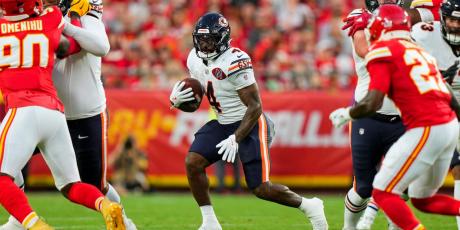The Case for Frank Gore in Indianapolis

The Colts didn’t waste much time in signing Frank Gore, locking him up with a three-year contract worth $12 million on the first day of free agency. Gore was originally rumored to be going to the Eagles, but he picked the Colts due to their superior offensive personnel.
Gore joins a backfield that includes Dan Herron, Vick Ballard and Zurlon Tipton. Ahmad Bradshaw is still a free agent, but the Colts aren’t expected to bring him back after an injury-shortened season and some offseason trouble. (He was cited for possession of marijuana.)
Defining His Role
When asked about Gore’s role in the offense, head coach Chuck Pagano had this to say:
“I don’t think we would’ve gone after him and made the investment and made the decision to bring him in if we didn’t feel that [he’s an every-down back]. Based on what we saw on tape, there’s video evidence that he’s more than capable of still being that guy. Some guys are like that. Carry 1 through 20, they’re OK. And 20 to 30, they keep getting better as you wear defenses down. And I think Frank is that type of runner… From a mental standpoint, he gets it. And from a physical standpoint, the kid is as tough as nails. He’s one of the toughest guys that we’ve seen play this game. We still feel like, obviously, he has a lot left.”
After a 58.7% pass rate (14th highest in the league) in 2013, OC Pep Hamilton threw it 61.4% of the time last season, which was the 5th-highest in the league. Some of this had to do with the ineffectiveness of the running game, specifically Trent Richardson, who had the most carries (159), yards (519) and the lowest YPC (3.3) of any Colt who rushed the ball at least 11 times. As a result, the Colts had a 3.9 YPC as a team, even though Bradshaw (4.7) and Herron (4.5) were pretty solid in that metric. (This bodes well for Gore, by the way.) Regardless, the total number of carries stayed pretty even – 409 in 2013, 415 in 2014 – thanks to an additional 85 total plays in ’14.
It’s tough to pin down what sort of workload an every-down back would have in a Pep Hamilton NFL offense since the Colts haven’t had a true feature back in his two seasons calling the shots. Richardson averaged 15.0 carries (for 3.0 YPC) in his first five games with the team, until the Colts figured out that he wasn’t going to be effective enough in that role. Last season, Richardson averaged 15.8 carries (for 3.6 YPC) from Week 2 to Week 7, so that appears to be what the Colts would like to do at the RB position from a workload standpoint.
Considering Pagano’s talk about Gore’s effectiveness in the 20- to 30-carry range, I’d expect they are planning to feed him the ball. He has averaged 16.4 carries per game over the past three seasons for the run-heavy 49ers, so 15-16 carries seems like a reasonable target for Gore since he doesn’t have much competition in Indy.
Role In The Passing Game
From a fantasy value standpoint, Gore can make his biggest leap in the passing game. He averaged 51.0 receptions from 2006-2010, which was the 4th-most among all running backs in that span. But as soon as Greg Roman took over as the 49ers’ offensive coordinator in 2011, Gore’s targets dropped precipitously. He averaged just 28.3 targets and 18.0 catches over the past four seasons. Meanwhile, the Colts’ running backs accounted for an average of 111 targets over the past two seasons, so Gore should be much more involved as a receiver.
Here’s a look at his range of potential fantasy production based on his projected touches. To estimate yardage, I used his yards per carry over the last two years (4.2) and estimated his yards per catch to be 8.0, which is 5% lower than his career mark of 8.4. To estimate touchdowns, I used his career touchdown rate of 2.6% for carries and 3.2% for catches. For reference, the Colts’ running backs came in at 2.5% and 6.3%, respectively, over the past two years, so I believe these estimates to be fair.
| Catches | |||||
|---|---|---|---|---|---|
| Carries | 30 | 40 | 50 | 60 | |
| 224 | RB16 (RB16) | RB12 (RB14) | RB9 (RB11) | RB8 (RB10) | |
| 240 | RB14 (RB14) | RB10 (RB11) | RB9 (RB10) | RB7 (RB9) | |
| 256 | RB12 (RB11) | RB10 (RB11) | RB8 (RB9) | RB7 (RB8) | |
| 272 | RB10 (RB11) | RB9 (RB9) | RB7 (RB8) | RB6 (RB7) | |
As you can see, Gore is coming in as a solid RB2 in both PPR and standard (in parenthesis) even when we use the lowest estimates for carries and catches. As we increase his projections in either category, he quickly moves towards RB1 status. This is not hugely surprising since Gore hasn’t finished outside the top 21 in PPR formats in the last nine seasons and has had an average rank of 12.6 in that span. From 2006 to 2010 – when he was actually involved in the passing game – Gore finished with an average ranking of 9.4 in PPR formats.
Will He Stay Healthy?
So this begs the question – will the soon-to-be 32-year-old remain productive and stay healthy in his 11th NFL season?
Two years ago, I looked at how age and/or workload affected RB health, and when Gore’s metrics (2,784 career touches, 266 LY touches, 558 L2Y touches and 16.0 GP L2Y) are plugged in, no red flags go up. According to the numbers, Gore can be expected to play 13-14 games, which is average for a running back. It should be noted that the inspiration for the study – Steven Jackson and Arian Foster – both missed significant time in 2013, so there are no guarantees when it comes to running back health. But Gore is a pro and he hasn’t missed a game in four seasons. If we’re going to bet on an aging running back to play a full season, then Gore fits the profile.
As insurance, prospective owners could draft Herron as a handcuff, provided he doesn’t get beat out by Ballard or someone else. Herron should come very cheaply on draft day, and managed to score 11.5 FP in PPR formats in the six games in which he saw at least 10 touches. Those are solid RB2 numbers.
But back to Gore – he gets a bump in value this year, especially in PPR leagues. If this were Alfred Morris and his 37 career receptions changing teams, I wouldn’t be quite as confident that he would catch 40-60 passes with the Colts. But this is Frank Gore – he’s done it before, and he should do it again in 2015.






















